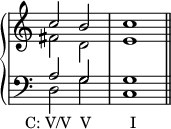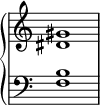The following is a list of musical chords and simultaneities:
| Code | Chord type |
|---|---|
| Major | Major chord |
| Minor | Minor chord |
| Augmented | Augmented chord |
| Diminished | Diminished chord |
| Indeterminate | Indeterminate chord |
| Predominant | Predominant chord |
| Suspended | Suspended chord |
| M3+b5 | Major third, flat five |
| Just | Just intonation |
| Bitonal | Bitonal chord |
| Atonal | Atonal chord |
| Name | Chord on C | Sound | # of p.c.-Forte # | p.c. #s | Quality |
|---|---|---|---|---|---|
| Augmented chord |  | ⓘ | 3-12 | 0 4 8 | Augmented |
| Augmented eleventh chord [1] |  | ⓘ | 6-34B | 0 4 7 t 2 6 | Major |
| Augmented major seventh chord |  | ⓘ | 4-19B | 0 4 8 e | Augmented |
| Augmented seventh chord |  | ⓘ | 4-24 | 0 4 8 t | Augmented |
| Augmented sixth chord |    | 3-8A 4-25 4-27B | 0 4 t 0 4 6 t 0 4 7 t | Predominant | |
| Diminished chord |  | ⓘ | 3-10 | 0 3 6 | Diminished |
| Diminished major seventh chord |  | ⓘ | 4-18A | 0 3 6 e | Diminished |
| Diminished seventh chord (leading-tone and secondary chord) |  | ⓘ | 4-28 | 0 3 6 9 | Diminished |
| Dominant |  | ⓘ | 3-11B | 0 4 7 | Major |
| Dominant eleventh chord |  | ⓘ | 6-33B | 0 4 7 t 2 5 | Major |
| Dominant minor ninth |  | ⓘ | 5-31A | 0 4 7 t 1 | Major |
| Dominant ninth |  | ⓘ | 5-34 | 0 4 7 t 2 | Major |
| Dominant parallel |  | ⓘ | 3-11A | 0 3 7 | Minor |
| Dominant seventh chord |  | ⓘ | 4-27B | 0 4 7 t | Major |
| Dominant seventh flat five chord |  | ⓘ | 4-25 | 0 4 6 t | Diminished |
| Dominant seventh sharp nine / Hendrix chord |  | ⓘ | 5-32B | 0 4 7 t 3 | Major |
| Dominant thirteenth chord |  | ⓘ | 7-35 | 0 4 7 t 2 5 9 | Major |
| Dream chord |  | ⓘ | 4-6 | 0 5 6 7 | Just |
| Elektra chord |  | ⓘ | 5-32B | 0 7 9 1 4 | Bitonal |
| Farben chord |  | ⓘ | 5-Z17 | 0 8 e 4 9 | Atonal |
| Half-diminished seventh chord |  | ⓘ | 4-27A | 0 3 6 t | Diminished |
| Harmonic seventh chord |  | ⓘ | 4-27B | 0 4 7 t | Major |
| Leading-tone triad |  | ⓘ | 3-10 | 0 3 6 | Diminished |
| Lydian chord |  | ⓘ | 5-20B | 0 4 7 e 6 | Major |
| Magic chord |  | ⓘ | 8 | 0 1 5 6 t 0 3 5 | Just |
| Major chord |  | ⓘ | 3-11B | 0 4 7 | Major |
| Major added-second chord |  | 4-24 | 0 2 4 7 | Major | |
| Major eleventh chord |  | ⓘ | 6-Z25 | 0 4 7 e 2 5 | Major |
| Major seventh chord |  | ⓘ | 4-20 | 0 4 7 e | Major |
| Major seventh sharp eleventh chord |  | ⓘ | 5-30B | 0 4 8 e 6 | Augmented |
| Major sixth chord |  | ⓘ | 4-26 | 0 4 7 9 | Major |
| Major sixth ninth chord ("6 add 9", [2] Nine six, [3] 6/9) |  | ⓘ | 5-35 | 0 4 7 9 2 | Major |
| Major ninth chord |  | ⓘ | 5-27A | 0 4 7 e 2 | Major |
| Major thirteenth chord |  | ⓘ | 7-35 | 0 4 7 e 2 5 9 | Major |
| Mediant |  | ⓘ | 3-11A | 0 3 7 | Minor |
| Minor chord |  | ⓘ | 3-11A | 0 3 7 | Minor |
| Minor added-second chord |  | 4-20 | 0 2 3 7 | Minor | |
| Minor eleventh chord |  | ⓘ | 6-32 | 0 3 7 t 2 5 | Minor |
| Minor major seventh chord |  | ⓘ | 4-19A | 0 3 7 e | Minor |
| Minor ninth chord |  | ⓘ | 5-27B | 0 3 7 t 2 | Minor |
| Minor seventh chord |  | ⓘ | 4-26 | 0 3 7 t | Minor |
| Minor sixth chord |  | ⓘ | 4-27A | 0 3 7 9 | Minor |
| Minor sixth ninth chord (6/9) |  | ⓘ | 5-29B | 0 3 7 9 2 | Minor |
| Minor thirteenth chord |  | ⓘ | 7-35 | 0 3 7 t 2 5 9 | Minor |
| Mystic chord |  | ⓘ | 6-34A | 0 6 t 4 9 2 | Atonal |
| Neapolitan chord |  | ⓘ | 3-11B | 1 5 8 | Major |
| Ninth augmented fifth chord [2] [4] |  | ⓘ | 5-33 | 0 4 8 t 2 | Augmented |
| Ninth flat fifth chord [2] |  | ⓘ | 5-33 | 0 4 6 t 2 | M3+b5 |
| Northern lights chord |  | ⓘ | 11-1 | 1 2 8 0 3 6 7 t e 4 7 | Atonal |
| "Ode-to-Napoleon" hexachord |  | ⓘ | 6-20 | 0 1 4 5 8 9 | Atonal |
| Petrushka chord |  | ⓘ | 6-30B | 0 1 4 6 7 t | Bitonal |
| Power chord P5 |  | ⓘ | 2-5 | 0 7 | Indeterminate |
| Psalms chord |  | ⓘ | 3-11A | 0 3 7 | Minor |
| Secondary dominant |  | ⓘ | 3-11B | 0 4 7 | Major |
| Secondary leading-tone chord |  | ⓘ | 3-10 | 0 3 6 | Diminished |
| Secondary supertonic chord |  | ⓘ | 3-11A | 0 3 7 | Minor |
| Seven six chord [5] |  | ⓘ | 5-25B | 0 4 7 9 t | Major |
| Seventh suspension four chord [6] |  | ⓘ | 4-23 | 0 5 7 t | Suspended |
| So What chord |  | ⓘ | 5-35 | 0 5 t 3 7 | Bitonal |
| Suspended chord |  | ⓘ | 3-9 | 0 5 7 | Suspended |
| Subdominant |  | ⓘ | 3-11B | 0 4 7 | Major |
| Subdominant parallel |  | ⓘ | 3-11A | 0 3 7 | Minor |
| Submediant |  | ⓘ | 3-11A | 0 3 7 | Minor |
| Subtonic |  | ⓘ | 3-11B | 0 4 7 | Major |
| Supertonic |  | ⓘ | 3-11A | 0 3 7 | Minor |
| Thirteenth flat ninth chord [2] |  | ⓘ | 6-27 | 0 4 7 t 1 x 9 [7] | Major |
| Thirteenth flat ninth flat fifth chord [2] |  | ⓘ | 6-Z49 | 0 4 6 t 1 x 9 [7] | M3+b5 |
| Tonic counter parallel |  | ⓘ | 3-11A | 0 3 7 | Minor |
| Tonic |  | ⓘ | 3-11B | 0 4 7 | Major |
| Tonic parallel |  | ⓘ | 3-11A | 0 3 7 | Minor |
| Tristan chord |  | ⓘ | 4-27A | 0 3 6 t | Predominant |
| Viennese trichord |  | ⓘ | 3-5A 3-5B | 0 1 6 0 6 7 | Atonal |
